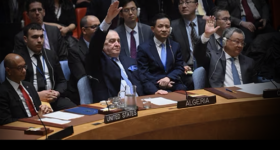Andrew McKillopentury
21st Century Wire
GETTING DESPERATELY CHEAP
Anybody who wants to know how Europe’s forced and mandatory Emissions Trading Scheme or
ETS works – or doesn’t work – needs only to check out the figures.
One barrel of oil emits about 430kilograms of CO2 when burned; 1 tonne of CO2 is therefore equivalent to burning about 2.25 barrels.European total CO2 output was about 5.1 billion tons, or 7.5 tons per capita in 2012, for a 3% decline on 2011 emissions according to Holland’s PBL Environmental Assessment Agency.
As of 11 February 2013, European carbon permits for December 2013 dropped as low as 4.22 euros
per tonne CO2 or CO2 equivalent of other greenhouse gases covered by the ETS, in permits trading on
London’s ICE Futures Europe exchange. Taking 4.50 euros or $6 as the carbon price, the total of all
European emissions, if they were covered by ETS (which is not the case), would have a nominal trade
value at current carbon prices of about $300 billion per year. Because ETS covers a claimed 45% of
total European greenhouse gas emissions, according to the European Commission, the total theoretical
value of permits covering all possible “fiscalized” or “marketized” emissions, at current traded price
levels, would be about 45% of $300 bn/year, that is $135 billion or 100 billion euros per year.
The large supermarket chain Wal-Mart’s turnover in 2012 was $444 billion.
In the first week of January, European emissions traders who shuffle EU emissions permits which
presently only cover about one-third (33%) of Europe’s total CO2 output, showed signs of kicking the
permits down the road to oblivion. Several market players have said they foresee carbon prices falling
to 2.50 euros per tonne or less, before the end of 2013.
The reason why the carbon price is almost certain to fall, even collapse, is drastically simple: there are
too many permits chasing too few emissions, but the EU’s agencies and institutions which handle the
issuance and allocation of this “carbon money” go on increasing its output. The technical term for this
over-issuance is “backloading” but the same term is used for the system’s very hypothetical protection
and safeguarding.
ENERGY LEVY
The present “carbon price” works out to a levy of approximately $3.40 per barrel of oil or barrel
equivalent of fossil-based energy in Europe. It may fall below $2 per barrel before the end of 2013.
This is a drastically unimpressive levy, relative to the very unrealistic figures touted by “insiders” as
recently as 2010: for instance then chief of the IMF, Dominique Straauss-Kahn who forecast global
emissions taxes and trading could rise to an equivalent of “up to $500 per tonne of CO2”, and market
turnover to “above $10 trillion a year” by or before 2020.
Some national governments, especially the UK, as recently as 2011, continued to scenarize future UK
CO2 taxes as high as, or more than $500 per tonne “by about 2025”.
The EU’s regulatory arm covering carbon pricing, and the majority of present member state
governments continue to argue that high, or very high carbon prices are “vital and necessary” to
encourage or force “needed power sector investment” in Europe to 2020, costed at 400 billion euro
(about $520 billion). Falling carbon prices can or will supposedly “compromise” this investment,
making it “uncertain” that official EU 2020 climate targets can be achieved.
These official statements of disquiet and concern are diametrically opposed by the action of European
Union authorities and entities issuing and distributing carbon permits. So-called “backloading”
has complex frills, such as the future role of carbon reduction commitments, Clean Development
Mechanism permits (CDMs), and CO2-equivalent permits for an alphabet soup of supposedly “climate-
threatening” gases, notably the fluon gases used in refrigeration equipment. However and basically,
backloading means cutting the supply of permits over a certain period – but not as soon as possible.
Analysts estimate it as unlikely there will be any cutback in supply earlier than Q4 2013, at best,
making it altogether possible that permit prices will collapse, potentially to 2.50 euros a tonne or far
less. After that, new material for making lampshades could become available!
One major reason for the “unreality component” in European Union response, or non-response to this
carbon money crisis is the refusal of Commission bureaucrats to accept that Europe is in recession.
The limits on CO2 discharges by “designated emitters” were set before the euro area entered what is
politely called “a W-shaped recession”, but in fact is an M-shaped recession, operating since 2008. The
bureaucratic system operating ETS is so multi-layered, opaque and cumbersone that there is little room
to prevent a decline in permit prices, because the existing allocation and issuance mechanism denies
that emissions can decline due to companies going out of business or shifting out of Europe. Any
reduction in emissions is officially believed to be due to emitters “cleaning up their act” and applying
new, more efficient technology.
The ETS assumes that “designated emitters’ will need to buy more permits as their activity expands in
the future. The reality of declining or stagnant activity is rejected, by European regulators and deciders.
The reality that any kind or type of additional energy levy, tax or charge, on top of existing ones is not
necessary or desirable in Europe, is also rejected.
THE BACKLOADING STAMPEDE
It is unfortunately probable that the backloading “experiment”, supposedly able to “save European
carbon trading”, will backfire. The present backloading proposals are the result of fevered talks
involving the Commission, the Investment Bank (EIB), close-linked European “carbon market maker”
banks and notably France’s Societe Generale, Germany’s Deutsche Bank and Britain’s Barclays Bank,
and other less-visible “players” such as agencies and entities controlling CDM payments, as well as
energy, environment, and finance ministries in countries with either high or low potential amounts of
permits to buy or sell.
The only agreement that has so far “emerged” was to make large-scale and repeated auctions of
permits “sometime soon”. Timing of these auctions has caused massive disarray among Europe’s
defenders of “carbon money”, resulting in the auctions being unlikely to start before Autumn ’13.
“Designated emitter” companies will need to buy almost half the annual permits they need in a few
weeks or months, under the proposed new system, which would be backdated to January ’13, when or
if it finally starts. In previous years, the “designated emitter” entities got most of there needed permits
for free, on a regular basis through the year, and had to buy extra permits only when and if needed. As
already noted, one of the biggest “reality hits” for ETS is that most designated emitters do not foresee
any need to buy additional permits – some are very simply going out of business – but their need to buy
permits was expected to be permanent by Europe’s permit system operators.
Today, accusations of open rigging of permit markets are not coming from isolated bloggers on the
Web – but as one example, from Poland’s Environment minister Marcin Korolec. His country is among
the “designated losers”, also including Cyprus, Estonia, the Czech Republic, Bulgaria and Romania
who stand to lose about 1.9 billion euros from 2013 to 2020, according to Korolec in December 2012.
To be sure, open swindling of permit buyers, by operators based in the above countries has been
common, as the same swindling operated from other countries. One “classic” swindle needing the
connivence of national authorities was the “recycling” of used carbon permits by the same government
agencies which received free permits. The permit were sold outside their “home country” a second
or third time, after wiping clean the data on the permit. This particularly concerned the “exotic gas”
permits, such as fluon-type refrigerant gases with a higher face value per tonne CO2 equivalent, and
the corruption-riddled CDM compensation system which has already suffered a complete collapse of
carbon prices, to far below 1 euro per tonne CO2.
The EU plan to sell fewer permits in the three years 2013-2015 will probably be delayed until
next year, according to UniCredit. UBS of Switzerland in January 2013 said that EU nations will
probably discuss the plan throughout 2013, not arrive at any coherent result and then abandon it next
year. The company forecasts prices at a maximum of around 6 euros a tonne in 2013, and probably
falling “considerably” after that.
Connie Hedegaard, the bloc’s climate-action commissioner, said in November that the carbon
market “needs clarity on backloading” but as many as 9 or 10 of the EU’s 27 member states may either
vote against, or abstain from voting when or if the “ETS crisis” moves back up to the high ground.
European governments may formally vote on the strategy in March 2013, according to EU officials in
Brussels.
THE REAL WORLD MOVES ON
The 17-nation Eurozone’s economy will contract at least 0.5% in Q1 2013 according to analysts’
forecasts, necessarily and further dragging down emissions permits turnover, on permits with a
delcining unit value. For 2012 against 2011, the value of transactions in the global carbon market made
up of the EU27, Australia and New Zealand (New Zealand will quit this system in 2013), dropped by
36% to a claimed year-total of 61 billion euros, and may decline to as little as 45 billion euros in 2012
according to Bloomberg New Energy.
Due to a fatal combination of economic decline, de-industrialisation, delocalisation outside Europe,
improving energy efficiency, and the development of non-fossil energy the EU’s estimated surplus of
permits may swell to 1.3 – 1.5 billion tons CO2 equivalent this year, without backloading, according to
analysts at Barclays and Societe Generale. The same analysts, being optimistic, claim that backloading
could or might enable the carbon price to regain 2010 value levels of around 10 euros a tonne – but only
if member states agree on the backloading plan and prevent “over-issuance”.
The European Commission needs 255 out of the 345 total number of official votes from member states,
and approval from the European parliament, to tackle the “carbon glut”. Most observers are highly
sceptical about this Happy Ending, mainly because lawmakers and market actors will realize that
backloading does not offer any “silver bullet’ solution.
Merely implementing the presently unagreed and unsure backloading plan would seriously impact
confidence, and could well signal the complete abandonment of “carbon pricing” in Europe by way of
emissions permits trading.
The Commission has now revealed its shaky hand by proposing a plan where auction delays will
be followed by another glut – simply a “rubber patch” attempt at fixing the market, which opens
up the Pandora’s Box of “non-market regulation” as the real alternative to fixing the probably non-
existent “problem” of global warming through human CO2 emissions.
These non-market measures will include tighter CO2 emission limits and cancellation of carbon
permits, as well as mechanisms to restrict re-imported offset credits, such as CDM offsets (now worth
a princely 43 euro cents per tonne) and then will move on to simple energy taxes – which are already
extremely high in Europe.
Andrew McKillop is a former expert in policy and programming with the European Commission in Brussels. He writes and consults about the impact of oil prices on the economy and currently advises the ECOHABITAT sustainable housing and property development project near the French, Belgium and Luxemburg borders.















